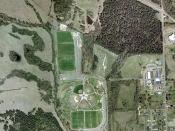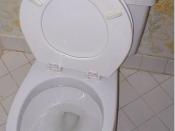When was the last time you stopped and listened to the flush of your toilet? I mean, really listen? Think about it, when was the last time you stood and just mediated on the gurgling sound a toilet makes as our waste is carried off into the great unknown? I thought so. It's been awhile, hasn't it? Maybe too long. That flushing sound is only the beginning of an astonishing journey which occurs billions of times a day in homes, restaurants, schools, stores and countless other places all with the pressing of a handle.
What happens to our waste after we have finished our usual custom of relieving ourselves? When we flush the toilet, we're actually in a sense, breaking a wine bottle on the helm of a maiden ship. That handle that we press is our waste's ticket to an exciting rollercoaster ride. How does this all happen? Let's watch as Mr.
Jones demonstrates the mechanisms of this miraculous invention.
The handle on the left side of the toilet is attached to a chain. This chain, in turn, is connected to a stopper located in the center of a tank filled with water, behind the toilet seat. Looking down into the tank, you can see that this stopper plugs a large hole in the tank, which prevents excess water from flowing into the bowl. As Mr. Jones presses this handle, it pulls the chain attached to it. Through a complicated form of physics, the chain lifts the stopper that plugs that hole in the center. Lifting this stopper allows the water that is stored in the tank to fill the bowl in a matter of seconds. Exactly like pulling the plug from a bath tub filled with water. When a large amount of water is added to the toilet bowl, it'll automatically flush. Why? Because of an oddly shaped pipe called the bowl siphon. If you were to slowly add water, cup by cup, to the toilet bowl nothing would happen. It will fill up until a certain point and then just stop. According to Marshall Brian, it'll only raise the water level slightly in the siphon and then the spill over into the drain, leaving some air at the crest of the pipe which will not activate the siphon. On the other hand, if you were to quickly add 2 gallons of water to the bowl, it would fill the siphon and push out any air that might be present there. This will start the siphon and cause suction and literally pull the water from the bowl into a hole at the bottom of the bowl called a siphon jet and down into the pipes (Brian, pg. 3). So, when Mr. Jones pressed the handle, it opened that plug in the center of the water tank and released all that water from the tank into the bowl which filled and activated the siphon causing it to flush. As soon as the bowls empties, the siphon fills back up with air and creates a peaceful gurgling sound. But what happens when the siphon doesn't fill back up with air? When particles, including toilet paper and the unmentionables prevent the siphon from filling up again with air, it causes the toilet to clog. These particles are blocking the siphon and preventing air or water from entering and flowing through it.
So, how does that bowl fill back up again with water? Well, inside of that water tank, there is also a device called a filler float. A filler float floats on the top of the water much like a bobber on the end of a fishing line. When the toilet is flushed, all the water rushes from the tank into the bowl which causes the filler float to fall. When it falls, it turns on a filler valve, that tells the stopper to close to prevent anymore water from escaping. The water comes from a supply tank which is attached to the toilet by a small pipe, usually to the left of the toilet seat. This allows water from our water pipes to re-fill the tank and the bowl. So, when the stopper closes, water fills back up in the bowl and the tank, ready for the next round. The water fills up slowly. Not too slowly, but slow enough that if Mr. Jones were to press the handle again shortly after the first flush, he'd only get a sort of half flush. The reason for this is that there is not enough water in the tank to quickly fill the siphon with water and activate it.
The flush is only the beginning, though. The tip of the iceberg, if you will. After the flushing, our waste travels through the countless miles of twisted pipes in our sewage system. It sails, underneath the pavement that we walk on everyday, as it continues it's journey. Eventually, our waste will end up in a waste water treatment plant where it's placed in tanks and then raked through to eliminate plastic bags, rocks and things of that nature. After that, our waste is broken down into smaller components. Oxygen is then pumped up through it so that tiny microorganisms can grow and feed on it. This create biosolids that are used as fertilizers. The water is sterilized and sent out and used, according to Howard Pearlman, as either irrigation or else returned to the environment (Pearlman).
So, you can now begin to see how miraculous a toilet really is. The toilet is one of those amazing things that we take for granted. We rarely stop to think about what is taking place when we flush a toilet, or even where it all goes. Toilets deserve more attention then they're getting. Next time you enter a restroom, whether it be at school, in a restaurant, at a store or even at home, stop and think about what is happening when you press that handle. Offer up in a quiet prayer and just meditate on that sweet musical flush.
Works Cited:
1. Brian, Marshall. "How Toilets Work." How Stuff Works. Shanna Freeman. 2006.
The Bowl Siphon, page 3. Oct. 13 2006 .
2. Pearlman, Howard. "Water Science for Schools." USCG Science for a Changing World. Tuesday, 30 Aug 2005. Question #6. Oct. 13 2006 http://ga.water.usgs.gov/edu/qahome.html#HDR6>.

![Rosalie Jones' Army [Suffragettes] (LOC)](https://s.writework.com/uploads/17/172375/rosalie-jones-army-suffragettes-loc-thumb.jpg)
